Removing kitchen countertops can be a daunting task, but it doesn’t have to be. With the right tools and a bit of know-how, anyone can easily remove their old kitchen countertop and replace it with something new. This guide will provide you with all the information you need to successfully remove your existing countertop and install a brand new one in its place. You’ll learn how to properly prepare the area before getting started, as well as what type of tools are needed for this job. Finally, we’ll cover some tips on how to make sure your installation goes smoothly and safely.
Materials And Tools

In order to successfully remove your countertop, you’ll need the following materials and tools:
- Hammer
- Pry bar
- Putty knife
- Safety glasses
- Dust mask
- Drill with screws and drill bit (if necessary)
- Protective gloves
- Reciprocating saw
- Utility knife
- Pencil and ruler
- Level
- Adhesive remover (if necessary) [1]
Steps For Removing Countertops Yourself
Let’s take a closer look at how you can remove the countertop yourself.
Gather Supplies
Gather all the necessary supplies for completing the job. Depending on what type of countertop you have, you may need a variety of tools such as a hammer, screwdriver, drill, pry bar and chisel. Additionally, you will need safety goggles to protect your eyes from flying debris when removing the countertop.
Clear The Area Of Obstructions
Before beginning, move any items that may be in the way of your work. This could include small appliances on the counter, such as toasters or blenders. It is also important to disconnect any plumbing and power connections before you start.
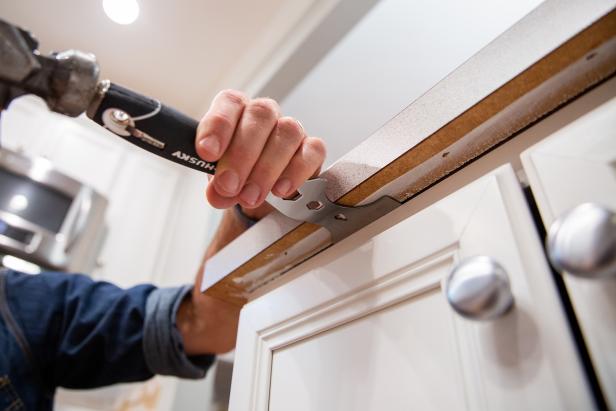
Disconnect Supply Lines To Countertop Fixtures
Before you begin to remove the countertop, it is important that you disconnect any supply lines connected to countertop fixtures. This includes water lines for sinks, dishwashers, and ice makers. It also includes gas lines for cooktops and other appliances. Once these have been disconnected, turn off the hot and cold shutoff valves located underneath the sink or behind your appliances. If you are uncertain on how to properly disconnect these supply lines, consider hiring a professional plumber for assistance.
Remove The Sink
Before you can remove your kitchen countertop, you’ll have to disconnect and remove the sink. This will require you to shut off the water supply and then unplug the drain pipe and faucet. Once that is done, use a utility knife to cut away any caulk sealant around the edges of the sink. Then, unscrew any mounting screws that hold it in place. Finally, lift out the sink carefully and set aside for reuse or disposal.
Loosen The Remaining Adhesive
Once the countertop has been cut, it is time to begin loosening the remaining adhesive. If there is any caulking or sealing around the edges of the countertop, use a putty knife or utility knife to carefully pry away these pieces. Once all of the caulk and sealant have been removed, apply a solvent-based adhesive remover to any areas that are still stuck down with glue. Let this soak for at least 15 minutes before using a putty knife or other tool to scrape away any remaining bits of adhesive. Be sure to wear safety glasses and gloves when working with harsh chemicals. When all of the adhesive has been removed from the surface, wipe clean with strong cleaner such as rubbing alcohol or a degreaser.
Unscrew And Pry Countertops From Cabinets
The next step in how to remove kitchen countertops is to unscrew and pry them from the cabinets. Start by finding all of the screws that are securing your countertop to the base cabinets. Begin by using a screwdriver to loosen each one. Once all of the screws have been removed, you can start to pry up the countertop by inserting a flat pry bar between the cabinets and counter. Work your way around the perimeter of the counter, taking care to not damage any of the surrounding areas. Once you’re finished, you should be able to lift up the entire countertop from its place in your kitchen.
Lift Away And Dispose Of Your Old Countertops
Removing your kitchen countertops is a big job, but it’s certainly something you can do yourself. Start by completely disconnecting any electrical outlets or appliances that are connected to the countertop. Once you’ve done this, you’re ready to move on to lifting away and disposing of the old counters.
Take a look under your countertop to see how it’s connected. Most often, kitchen countertops will be attached with screws into a frame of supports and brackets that sit beneath the counter. Use an electric screwdriver to remove these screws from their mounts. Once you’ve done this, you should be able to lift away the countertop.
How To Remove Laminate Countertops
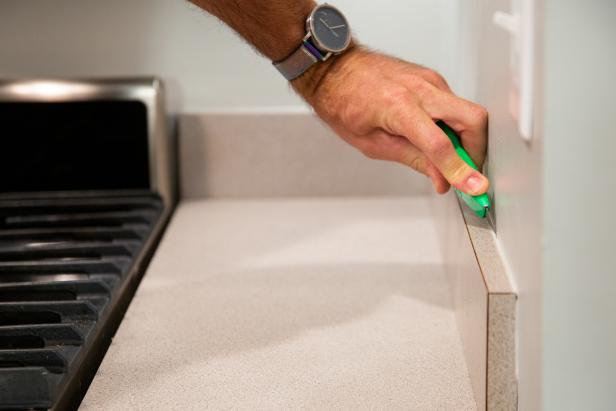
Removing laminate countertops is a relatively simple task. You will need to be careful when removing the countertop, as it may contain sharp edges. Here are the steps you should take to safely remove your old laminate countertop:
- Unscrew and disconnect any attachments such as towel racks or soap dishes that are connected to the countertop.
- Unscrew and remove any screws or brackets that are holding the countertop in place. Try not to damage the walls; you may need to use a pry bar or putty knife to help remove stubborn attachments.
- Carefully pull out the laminate countertop from the cabinets and lay it on a flat surface.
- Discard the old countertop in a safe manner, making sure to wear protective gloves as the edges may be sharp.
- Clean up any debris or residue left from removing the countertop such as nails, screws, or brackets. You can use a vacuum cleaner or broom and dustpan for this.
- Prepare the surface for installation of a new countertop by filling any holes from the previous screws with putty and sanding down any rough edges.
- Disconnect the plumbing and electric lines. Before beginning the removal process, it is important to turn off the power supply and disconnect all water lines connected to the sink and countertops.
- Remove all appliances, such as stoves and microwaves, that are connected to the countertop.
- Score the caulk line between the granite countertop and wall using a utility knife. This will help break up the sealant so you can remove it more easily.
- Use a pry bar to loosen the countertop from the base cabinets. You should be able to start lifting it up slowly with the help of a partner or two. It’s important to wear safety goggles and gloves for this process, as granite is heavy and sharp!
- Once you have lifted the countertop, you can start removing the adhesive underneath. Start with a putty knife and then use an oscillating tool to scrape away any excess adhesive.
- Vacuum the area to clear away any dust or debris that was left behind from removing the countertop.
- Finally, remove all remaining parts of the countertop and dispose of them properly.
- Measure the space before purchasing a new countertop. Make sure it will fit in the existing area and that there is enough material for any overhangs or cutouts you want to make.
- Remove all items from the countertop and disconnect any plumbing connected to the sink. Disconnect any appliances, such as electric cooktops.
- Unscrew the old countertop from the cabinets or walls and carefully remove it. Be sure to wear protective gloves, as this can be a very dirty job.
- Clean the area with an appropriate cleaner such as bleach or vinegar and water solution, then let dry completely before proceeding.
- Make any necessary cuts or modifications to the new countertop before attempting to install it.
- Install supports in the base cabinets or walls when needed for heavier materials such as granite and marble.
- Position the countertop in place, then use screws and/or adhesive to secure it down properly.
- Reinstall the sink and any appliances, then connect the plumbing correctly.
- Caulk around the edges of the countertop to create a waterproof seal and protect it from dirt and moisture.
- Finally, add any desired finishing touches such as edging or trim for a professional look. [4]
- https://www.hgtv.com/design/rooms/kitchens/remove-kitchen-countertop
- https://www.dumpsters.com/blog/how-to-remove-countertops
- https://www.cravingsomecreativity.com/5-tips-replacing-countertops/
- https://www.clearabee.co.uk/guides/kitchen-removal/countertop
How To Remove Granite Countertops
Granite countertops are a popular kitchen feature, but they can be quite tricky to remove. Here are some steps to help you successfully uninstall granite countertops in your kitchen:
Removing granite countertops can be a daunting task but with the right tools and knowledge, it is possible to get the job done safely and effectively. [3]
Tips For Replacing Countertops
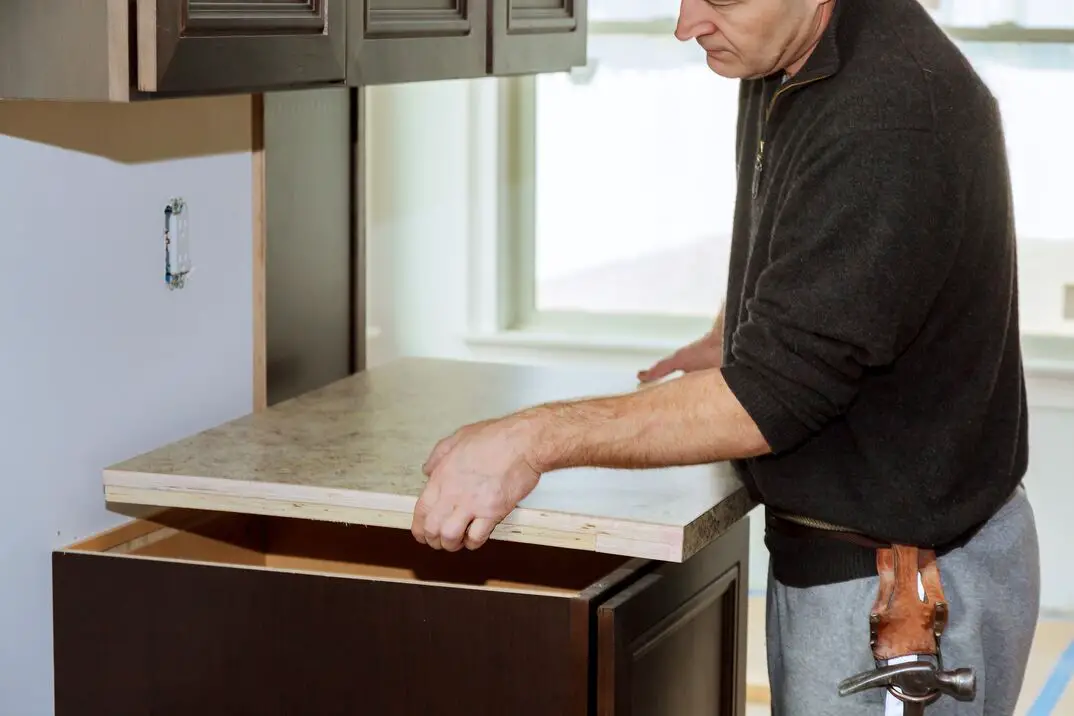
By following these steps, you can easily replace your countertops and give your kitchen an updated look. With a little effort, you can enjoy the new look of your kitchen without spending too much money or time.
FAQ
Can you remove the countertop without damaging cabinets?
Yes, it is possible to remove a countertop without damaging the cabinets. However, it requires careful planning and execution. First, you should disconnect all cables and pipes that run through the countertop by turning off the water supply, unplugging any outlets, and removing any connected appliances such as dishwashers or stoves. Next, you will need to carefully pry off the countertop with a putty knife or screwdriver, being careful not to damage the cabinets underneath. Finally, you will be able to easily remove the countertop itself, but make sure to have someone help you lift it as it is likely very heavy.
Is it difficult to remove a countertop?
Removing a kitchen countertop can be a difficult task and should only be attempted by experienced DIYers.
Depending on your kitchen’s layout, you may need to remove cabinets around the perimeter of the countertop before being able to access the counter itself. In addition, some countertops are glued to the cabinet structure while others are fastened with screws. Therefore, it’s important to carefully assess the situation before beginning a countertop removal project.
Can you remove the countertop without breaking it?
Yes, it is possible to remove a kitchen countertop without breaking it. The key is to plan and take precautions before you start the project. To begin, make sure your tools are in good condition and that you have all of the necessary safety gear (goggles, gloves, etc.). Then measure the size of your countertop and determine how it is affixed to the cabinet or wall. If it’s glued down, use a putty knife or other flat-tipped tool to gently pry up one corner at a time until you can lift the entire piece off. If it’s nailed or screwed into place, use an appropriate screwdriver/drill bit to loosen each fastener until free.
Once the countertop is removed, use a pry bar to gently and carefully remove any remaining nails/screws before disposing of it. Finally, patch up any holes or damage left behind with wood putty and sandpaper before installing the new countertop.
How are kitchen countertops attached?
Most kitchen countertops are attached to the base cabinets with screws, nails, or a combination of both. Some countertops may be glued directly to the cabinets, while others may be held in place with clips and brackets. Depending on the type of installation you have, your removal process will vary. For countertops secured by screws and nails, you’ll need to locate them first. Carefully look around the back edges of your countertop for any visible screws and use a screwdriver to remove them. If your old countertop is being held in place with adhesive, use a putty knife or scraper to loosen it before trying to pry it off. Once all of the screws and nails have been removed and any adhesive has been carefully scraped away, you’ll be able to start the countertop removal process.
Can countertops be removed and reused?
Yes, it is possible to remove and reuse countertops depending on the type of material they are made from.
Materials such as laminate and solid surface can be easily removed without causing damage to them or the existing cabinets. Other materials such as granite and marble may need special tools or techniques in order to avoid damaging them when removing them. It is also important to consider any plumbing fixtures that may need disconnecting before attempting to remove a countertop.
How easy is it to remove kitchen worktops?
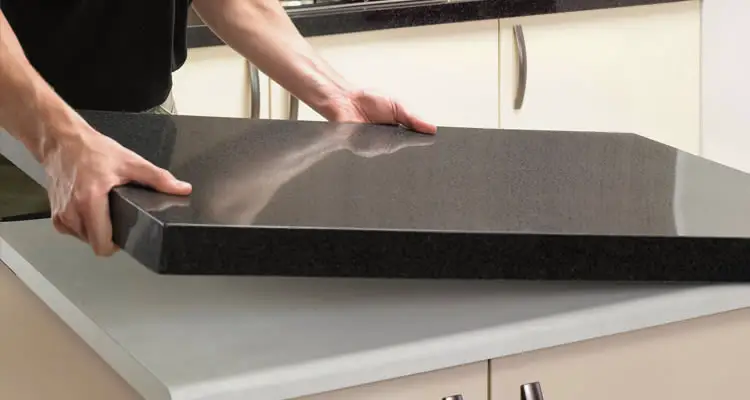
Removing a kitchen worktop can be relatively simple or complex depending on the type of countertop that was installed. If your countertop is tile, laminate, solid surface, or a similar material, then you may be able to take it off yourself in just a few steps. However, if your countertop is stone such as granite or quartz, it requires special tools and care to safely remove.
How do I remove a glued countertop?
Removing a glued countertop is not as simple as removing one that has been fastened with screws. It takes patience and the right tools to do it successfully. The most important thing to remember when removing a glued countertop is safety first. Wear protective eyewear, gloves, and a dust mask while performing this task. To begin, use a sharp utility knife or putty knife to cut through the caulk or adhesive along the edges of the countertop where it meets the wall. Apply gentle pressure while cutting and make sure you follow any patterns in the caulk so that you can remove it cleanly. Once all the caulk is removed, move onto the next step. Next, use a pry bar or demolition hammer to carefully remove the countertop from the wall. Go slowly and be sure to keep your body out of the way, as chunks of material may come loose. Work systematically and continuously check for additional adhesive before moving onto another section. Once all the countertop has been removed, clean up any remaining debris to prepare for installation of a new countertop.
How much does it cost to remove a countertop?
Removing a countertop can range from being relatively inexpensive to quite costly depending on the size, material, and complexity of the job. Generally speaking, it costs between $50 – $300 to remove a countertop. However, additional fees may be included such as disposal costs or charges for more complex installations. If you are looking to replace the countertop, the cost may be higher since you will also need to install a new one. Additionally, if your countertop is made of particularly high-end material such as marble or granite, you should expect to pay more for removal and installation.
Can I replace the kitchen countertop myself?
Yes! Replacing a kitchen countertop is a relatively easy DIY project. However, it does require some preparation and basic knowledge of how to use tools like a saw, drill, and screwdriver. Before beginning the project you should make sure that you have all the materials and tools needed on hand. This includes your new countertop panels, screws or other fasteners appropriate for your cabinets’ material type, caulk or sealant, mastic adhesive (if necessary), epoxy putty knife (for cleaning up old adhesives), and silicone caulk or sealant (to prevent water damage). You will also need safety equipment such as goggles and gloves to protect yourself while working. When taking out old countertop panels, be sure to wear gloves and eye protection to protect your hands and eyes from dust or debris.
Can I just change my kitchen countertop?
Yes, you can definitely change your kitchen countertop. You can either choose to remove the existing countertop and replace it with a new one or use a resurfacing kit to give it a makeover. Removing an existing countertop is slightly more involved than simply replacing it since you need to first disconnect any pipes and electrical cables. To install the new one, you will need to cut it to size and secure it in place using construction adhesive. With a resurfacing kit, you can save yourself the hassle of disconnecting and installing a new countertop – simply apply the resurfacing product as per its instructions to give your existing countertop a brand-new look.
Useful Video: How To Remove Granite Countertops Without Breaking the Granite
Conclusion
Removing kitchen countertops is a job that can be tackled by any homeowner with a few basic tools. For most people, it will take about an hour to remove their existing countertop and another two hours for the new one to be installed. It’s important to remember to turn off all utilities before beginning the project, as well as wear protective gloves and goggles to avoid injury. After the countertop has been removed, you should thoroughly clean the area to ensure that no particles or dust remain before installing the new countertop.
References





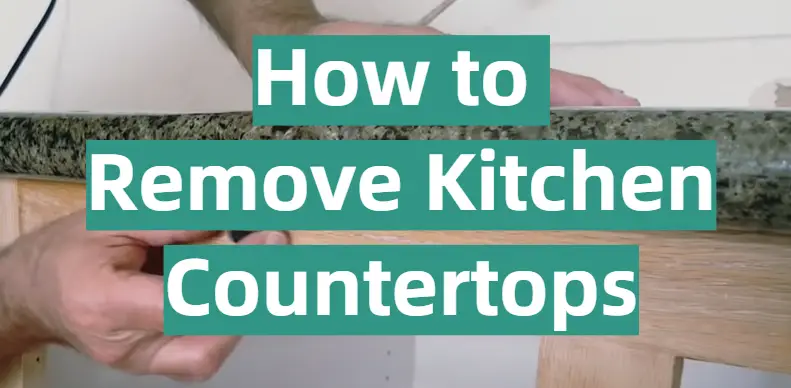





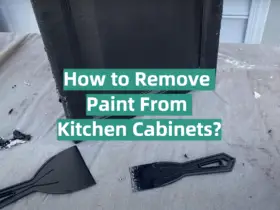
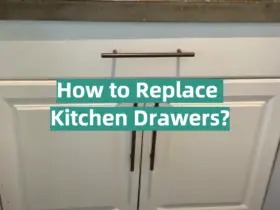

Leave a Reply